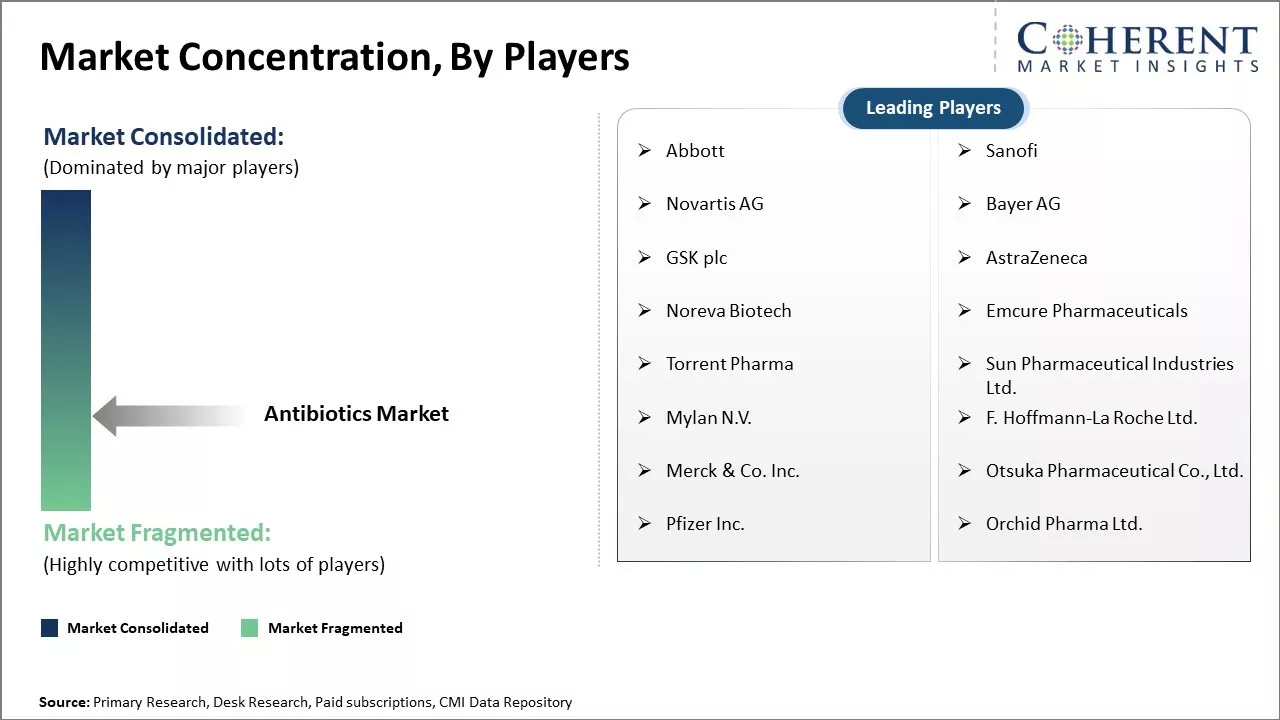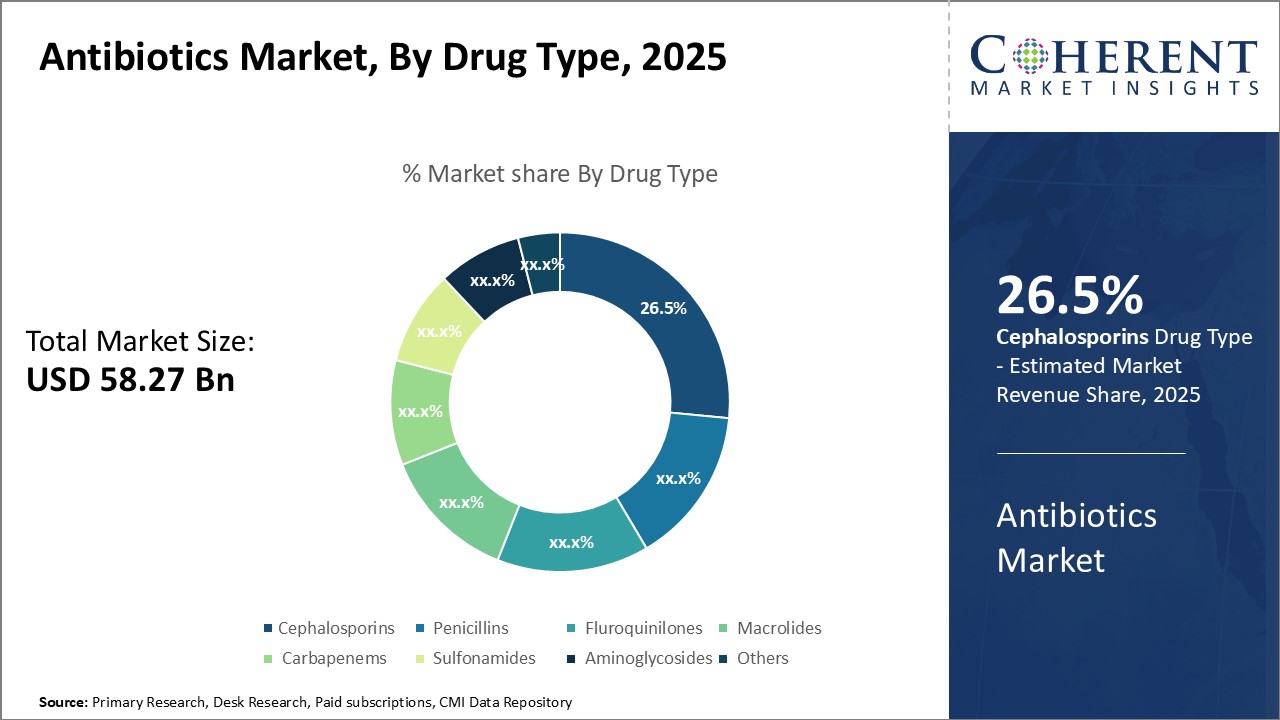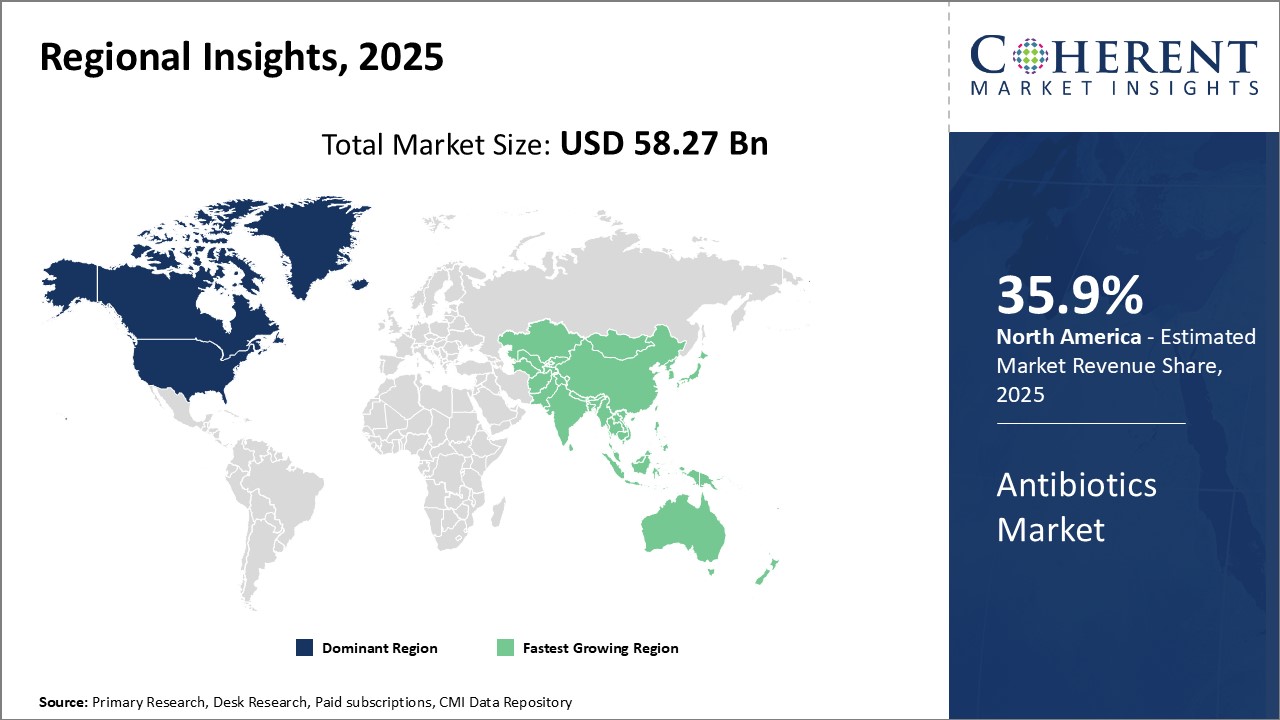Global antibiotics market is estimated to be valued at USD 58.27 Bn in 2025 and is expected to reach USD 83.70 Bn by 2032, exhibiting a compound annual growth rate (CAGR) of 5.3% from 2025 to 2032.

Discover market dynamics shaping the industry: Request sample copy
The antibiotics market is witnessing positive trends with the increasing demand for effective antibiotics for the treatment of bacterial infections. Rising prevalence of infectious diseases and growing awareness about antibiotic treatment options are expected to drive the market growth. Additionally, the market is also benefiting from recent new product launches with improved formulations and novel drug delivery systems. However, overutilization and misuse of antibiotics have led to antimicrobial resistance which remains a major challenge. This has encouraged manufacturers to invest more in the research and development of advanced antibiotics. Stringent regulations regarding the use of antibiotics are also being implemented to prevent antibiotic resistance.
High Consumption of Antibiotics across the Globe
High consumption of antibiotics across the globe is expected to augment the growth of the global antibiotics market during the forecast period. For instance, antibiotics are medicines that fight bacterial infections in people and animals. They kill bacteria or prevent them from reproducing and spreading, and thus, there is an increase in the demand for antibiotics worldwide. According to the new research conducted by the Lancet Regional Health-Southeast Asia in September 2022, Azithromycin 500 mg tablet was the most consumed antibiotic formulation (7.6%) in India, followed by cefixime 200 mg tablet (6.5%).

Get actionable strategies to beat competition: Request sample copy
Rising Prevalence of Infectious DiseasesRising prevalence of infectious diseases around the world is expected to propel the growth of the global antibiotics market during the forecast period. For instance, antibiotics are powerful medicines that fight bacterial infections. Antibiotics are used to treat or prevent some types of bacterial infections. As per the Centers for Disease Control and Prevention (CDC), in 2020, around 7,174 new cases of tuberculosis (TB) were reported in the U.S. Moreover, the common cold affects millions of people in the U.S. every year.
Key Takeaways from Analyst
The global antibiotics market faces opportunities for growth due to rising antimicrobial resistance worldwide. Growing resistance to existing antibiotics is a key driver as it is prompting increased R&D for new drug classes. Stringent regulations for drug approval pose a restraint across markets. Producers are also challenged by shrinking pipelines and fewer new antibacterial drugs in development. Alternatives to traditional antibiotics are gaining interest as preventive therapies against bacterial infections. Injectable versions of antibiotics are seeing higher demand over oral formulations for severe hospital-acquired infections.
North America will continue to dominate the market given the strong pharmaceutical industry and high healthcare spending in the U.S. Asia Pacific is expected to emerge as the fastest growing regional market owing to its large population and improving access to healthcare.
Generic competition erodes prices of major drugs losing patent protection. However, premium products addressing multi-drug resistance strains may see insulated demand. Developing nations present opportunities for low-cost generic manufacturers to capture market share. Public and private initiatives to curb antibiotic overuse aim to optimize consumption and clinical outcomes long-term. Overall industry growth depends on the successful introduction of novel classes that can overcome rising drug resistance worldwide.
Market Challenges: Rise in Incidence of Antibiotic Resistance
Rise in incidence of antibiotic resistance is expected to hamper the growth of the global antibiotics market. For instance, antibiotic resistance is a serious public health problem. It occurs when bacteria develop the ability to survive exposure to antibiotics designed to kill them or prevent their growth. Moreover, it results in longer hospital stays, higher medical costs, and increased mortality.
Market Opportunities: Increasing Acquisition by Key Market Players
Increasing acquisition by key market players is expected to offer lucrative growth opportunities over the forecast period. For instance, in September 2021, Lincoln Pharmaceuticals, a pharmaceutical company announced that it had acquired a facility in Gujarat, India to launch Cephalosporin products. It intends to invest USD 3.59 (Rs 30 crores) in the Cephalosporin plant, including capacity expansion and modernization of the facility. The company is planning to manufacture 20 plus Cephalosporin products and is planning to start product registration soon for the domestic and exports markets.

Discover high revenue pocket segments and roadmap to it: Request sample copy
Insights, By Drug Type: Versatility and ResistanceDrug type segment is sub-segmented into cephalosporins, penicillins, fluroquinilones, macrolides, carbapenems, sulfonamides, aminoglycosides, and others. The alcohol addiction sub-segment is estimated to hold 26.5% of the market share in 2025, owing to its high versatility and growing resistance to other drug types. Cephalosporins are semi-synthetic antibiotics that continue to evolve, allowing them to treat a wide range of bacterial infections. Newer generations have been developed with an even broader spectrum of coverage. This versatility makes Cephalosporins highly preferable for empirical therapy when the causative organism is unknown. It also allows them to be used as a substitute when patients exhibit resistance or allergies to other classes like Penicillins. The rising microbial resistance towards historically effective drugs like Penicillins is a significant driver for the popularity of Cephalosporins. Bacteria have developed various mechanisms like efflux pumps and alteration of binding sites to resist Penicillins and other older antibiotic classes. On the other hand, bacteria have only accumulated resistance to early generation Cephalosporins so far. Later generations still retain their efficacy against most common pathogens. As resistance trends continue increasing pressure on traditional options, physicians and patients continue to rely more on the malleable Cephalosporin class for versatile therapy.
Insights, By Spectrum: Broad Coverage against Common Infections
Spectrum segment is sub-segmented into broad-spectrum antibiotics, narrow-spectrum antibiotics. The broad-spectrum antibiotics sub-segment is estimated to hold 54.2% of the market share in 2025, owing to the growing adoption of biologics and biosimilars. NSAIDS have been conventionally used as the first line treatment for relieving joint pains, fever, and swelling associated with Systemic Lupus Erythematosus (SLE). However, as the understanding of autoimmune pathways improved, biologics specifically targeting B-cells, T-cells and other cytokine pathways have replaced conventional NSAIDS for SLE patients with severe organ involvement or those inadequate responsive to NSAIDS. Innovation in the field of biologics has led to the approval of several autoimmune pathway inhibitors like belimumab, rituximab, hydroxychloroquine, and mycophenolate over the past decade. Additionally, patent expiration of blockbuster biologics has also fueled the market entry of their cheaper biosimilar counterparts. Both biologics and biosimilars collectively account for over 50% of the total SLE drug market currently owing to their superior efficacy and safety profile over NSAIDS especially for high risk SLE patients. This shift towards biologics from NSAIDS continues to positively impact the overall growth of the NSAIDS market segment.
Insights, By Route of Administration: Increasing Research and Development Activities for Oral Antibiotics
Route of administration segment is sub-segmented into oral, intravenous, and others. The oral sub-segment is estimated to hold 36.6% of the market share in 2025, owing to increasing research and development activities for oral antibiotics. For instance, on April 17, 2024, GSK plc, a pharmaceutical company, announced the positive results from the pivotal EAGLE-1 phase III trial for gepotidacin, a potential first-in-class oral antibiotic with a novel mechanism of action for uncomplicated urogenital gonorrhoea (GC) in adolescents and adults. Unlike intravenous therapies requiring hospitalization, or even intramuscular injections, orally available drugs empower patients to self-administer treatment from the comfort of their own homes. This degree of comfort and access increases adherence to prescribed dosing regimens. It also promotes faster drug intake at the first onset of symptoms, which is conducive for quicker clinical resolution.

Need a Different Region or Segment? Customize now
North America is the dominant region in the global antibiotics market and is estimated to hold 35.9% of the market share in 2025. This is due to the rising incidence of infectious diseases and growing healthcare expenditure by the government in the region. Antibiotics are used to fight bacterial infections. They either kill bacteria or stop them from reproducing, allowing the body to eliminate pathogens. For instance, the U.S. government is undertaking various measures to control infectious diseases such as antibiotic stewardship initiatives and R&D activities.
Asia Pacific is also expected to witness robust growth in the global antibiotics market due to the rising prevalence of infectious diseases, rising consumption of antibiotics, and favorable government initiatives in the region. For instance, antibiotics are widely used to prevent and treat bacterial infections. Used properly, antibiotics can save lives. India has emerged as one of the world's largest consumers of antibiotics. As per the National Center for Biotechnology Information (NCBI), India is the world's fourth largest consumer of antimicrobials for animal use, after China, the U.S., and Brazil.
Antibiotics Market Report Coverage
| Report Coverage | Details | ||
|---|---|---|---|
| Base Year: | 2024 | Market Size in 2025: | USD 58.27 Bn |
| Historical Data for: | 2020 To 2024 | Forecast Period: | 2025 To 2032 |
| Forecast Period 2025 to 2032 CAGR: | 5.3% | 2032 Value Projection: | USD 83.70 Bn |
| Geographies covered: |
|
||
| Segments covered: |
|
||
| Companies covered: |
Abbott, Sanofi, Novartis AG, Bayer AG, GSK plc, AstraZeneca, Noreva Biotech, Emcure Pharmaceuticals, Torrent Pharma, Sun Pharmaceutical Industries Ltd., Mylan N.V., F. Hoffmann-La Roche Ltd., Merck & Co. Inc., Otsuka Pharmaceutical Co., Ltd., Pfizer Inc., and Orchid Pharma Ltd. |
||
| Growth Drivers: |
|
||
| Restraints & Challenges: |
|
||
Uncover macros and micros vetted on 75+ parameters: Get instant access to report
*Definition: Antibiotics are medicines that fight bacterial infections in people and animals. These drugs help destroy or slow down the growth of bacteria. Antibiotics either kill bacteria or stop them from reproducing, allowing the body to eliminate pathogens. When used properly, antibiotics can save lives.
Share
Share
About Author
Vipul Patil is a dynamic management consultant with 6 years of dedicated experience in the pharmaceutical industry. Known for his analytical acumen and strategic insight, Vipul has successfully partnered with pharmaceutical companies to enhance operational efficiency, cross broader expansion, and navigate the complexities of distribution in markets with high revenue potential.
Missing comfort of reading report in your local language? Find your preferred language :
Transform your Strategy with Exclusive Trending Reports :
Frequently Asked Questions
Joining thousands of companies around the world committed to making the Excellent Business Solutions.
View All Our Clients
US Reciprocal Tax Impact Analysis On Antibiotics Market
Stay updated on tariff changes with expert insights and timely information